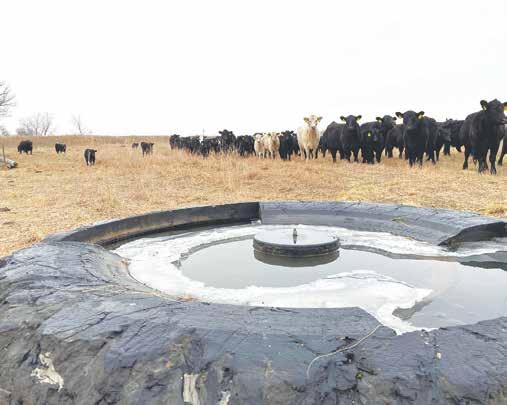
19 minute read
Farmer's Field
BY RON RABOU
Starting the New Year with purpose
Advertisement
The year 2023 has finally arrived, and I find I’m not looking back on 2022 with much fondness. In fact, I’ve talked to several folks who don’t have many positive things to say about the past year either.
Despite how difficult things may have been this past year, I do think there is always a silver lining in most everything, if we just choose to find it.
A new year, of course, tends to bring renewed hope and optimism. It is a time where we can push the reset button and look forward to new goals, renewed discipline and aspirations of great accomplishment.
The dilemma is our aspirations can often be much more exciting and motivating than the mundane daily routine of selfdiscipline to see our goals through to the very end. It’s just human nature.
It’s natural to have dreams and ambitions, but it’s also natural to become overwhelmed by life and responsibilities that come with it. Sometimes, our goals are so ambitious, when we don’t feel some success along the way, it’s pretty easy to give up.
Other times, our lack of accomplishment might be the result of setting goals that really don’t have much to do with who we are and what we actually want. They might be based on an image of what we think we are supposed to be.
To set a goal that is not a reflection of our true inner self can be more demotivating and harmful than we realize. Such a goal causes frustration. It can instill in us more self-consciousness and push us further away from our intended purpose. Most importantly, it can cause us to develop an even deeper fear of failure.
Various studies have shown only five to six percent of people who set goals actually achieve them. More alarming yet is only about 20 percent of people even set goals.
How can this be? How can we live in the freest country the world has ever known, one with opportunity bulging at the seams, and only a fraction of the population is intentional with what they want to accomplish, both personally and professionally?
The answer is quite simple – it’s hard. We live in a microwave society where we become impatient when our burrito doesn’t heat up fast enough. We can become frustrated when we want an answer online, and the internet connection is too slow.
Many people become easily angered when the driver in front of them is not going fast enough. Some folks take to social media and blame the airlines for not getting them to their destination quickly enough. What used to take weeks now just takes a few hours.
We have expedited shipping, accelerated degree programs, “freaky fast” food delivered to our doorstep, instant downloads and the list goes on. A younger generation often wants things now, which took their parents years to build.
I once had an employee tell me it was unfair my house was bigger than his. Ironically, the house he lived in for free was also one of mine. We want things our way, on our terms, and we want it now.
It's no wonder more people aren’t setting goals, let alone, accomplishing them. It’s easy for a person to say what they want without fully understanding what it takes to get there. It’s easy to look at others and say, “It must be nice,” while making assumptions about their life.
For nearly every successful person I know, there has been a long road full of obstacles, potholes, risk, hard work and sleepless nights to get to where they are today. Everyone wants a blue ribbon, but not everyone is willing to put enough work in to win the race.
Goals are hard because from the outside looking in, they are like a shiny object. They grab our attention, and we wish we could attain them. But from the inside, they can be mundane and routine, because that’s how they are realized – one step at a time, one decision at a time and one day at a time.
The question then becomes, how can we set goals bringing us closer to our purpose and reflect who we are as individuals –goals leading us to a sense of accomplishment rather than failure?
First, people need to forget what the world says and what their neighbors are doing and focus on being the best version of themselves. They need to uncover what brings them their greatest sense of accomplishment or significance, and their goals should reflect this. Then, they need to write them down.
Next, people need to tell themselves goals are not a destination. But instead, are a daily journey. They need to be patient and commit themselves to doing something each day, no matter how small it might be, to help move them in the direction of their goals.
Lastly, they need to remember to have fun. Not much in life is worth doing if a person can’t learn to enjoy the journey.
Here’s to a new year. It’s going to be a great one!
BLM hiring
The Bureau of Land Management (BLM) is currently seeking applicants for a temporary, seasonal summer range aid/technician in Casper and Cody for a six-month timeframe. Starting and ending dates can be negotiated, and the salary range is $14.38 to $20.14 per hour.
Duties for the position include assisting specialists in planning rangeland management support projects; checking range allotments to assess appropriate time to graze, compliance with management plans and operating instructions, number of livestock, herding procedures, salting, range improvement and maintenance; inspecting structural range improvements and notifying supervisors of needed maintenance.
Offering 45 Hd of Pap tested 2-year-old Black Angus Bulls
High elevation, ran on top of the Big Horn Mountains
Born in April/May 2021
AVG BW: 75 WW: 630 YW: 1120
Summered on grass, developed on a high roughage ration to last
AVG ribeye measured 13.2 inches
Average PAP score of 37 BVD, Carcass, PAP tested at elevation, Freeze branded and Semen Tested, Genomic Testing through AG BOOST
Absolutely no hoof trimming!
Additionally, individuals in this position will perform a variety of computations and assessment of standard rangeland management data to prepare the data for interpretative use of inclusion in reports; prepare charts, graphs and/or reports using well-established specified procedures; perform computations requiring judgment and knowledge of the nature of the sources and use of the data; estimate production and potential production of a site based on various sampling techniques; participate in noxious plant identification and control and identify plant specimens in the field and collects and prepares specimens.
For more information or to apply, visit usajobs.gov and search for announcement number WYTEMP-2311800951-MS or range aid/technician BLM. Questions about the position can be directed to Dustin Burger at 307-261-7515 or Matt Roberts at 307-261-7525. The window for submitting applications is Jan. 23 through Feb. 6.
Tour guide training offered
The National Historic Trails Interpretive Center in Casper is hosting two training opportunities in February for individuals interested in becoming educational tour guides. Trainings will be held at 10 a.m. on Feb. 4 and 11, with each session lasting approximately two hours.
• Free delivery to adjoining states and Nevada
When you’re buying a bull from us, you’re buying tested and proven, grass-based, maternal genetics with performance. Here’s the averages on what our steer calves did at Chappel Feedyards: 4.7 lbs/day
• Killed at 1,338 lbs, yielded 63%, a 841 lb. carcass • Avg. ribeye measured 14.2 inches
Participants of the training will have an opportunity to volunteer at the Trails Center leading large groups. Educational tour guides provide an immersive and engaging experience for school-aged children, as well as their parents and teachers and share information about the history and themes found at the Trails Center.
As a tour guide, individuals will interact with local students and teachers and provide historical information to the children, instilling a passion and connection with history to enhance their overall experience on the subject.
Individuals interested in the training should contact Jason Vlcan at 307-261-7783.
The National Historic Trails Interpretive Center is open seven days a week from 9 a.m. to 4:30 p.m. at 1501 N. Poplar Street, Casper, WY 82601. Admission is free.
We welcome obituaries. Obituaries are printed free of charge and can be sent to roundup@wylr.net.
Henry L. Wasserburger
May 18, 1931 – Jan. 18, 2023 attended Lusk High School and graduated May 1949. union five children were born: Henry L. III, Jolene (Tom) Lorraine, Joel (Laurie) David, Thomas (Val) Lee and William (Tracy) Jeffrey.
During high school, Henry was an outstanding football player and was selected as an all-state guard. He also played the saxophone and was a member of the band for the Legend of Rawhide Pageant.
Henry worked with his father until his passing in 1983, at which time he took over as the active manager of the ranch. In 1978, Joel returned to the ranch.
In May 1979, Henry, Lorraine and Joel formed the Bootheel Seven Livestock partnership, which is in existence today. Lorraine passed away Jan. 4, 1999.
Henry L. Wasserburger, Jr. was born on May 18, 1931. He was the first-born son to Henry L. Wasserburger and Anna Josephine (Pfister) Wasserburger in Lusk. Henry attended Fairview Rural School until the eighth grade. He then boarded in Lusk, where he
After graduation, he attended Regis College in Denver for one year. His love of sports carried him to many Denver area football and basketball games during this year. After his first year of college, Henry returned home to the family ranch north of Lusk.
On Sept. 12, 1951, Henry married his high school sweetheart, Lorraine Opal Wilson. To this
Irene T. (Bugas) Worthington
Nov. 8, 1925 – Jan. 9, 2023
Irene was a gem or model they do not make anymore. She was charitable, prayerful, fun, loving and supportive. She had an intense love of family and enjoyed visiting the ranch to be with family and her friends in Bridger Valley.
Henry was a very lucky man, and on Aug. 11, 2000, he married the second love of his life, Yvonne (Bonnie) Baures in Casper. His love of travel continued as they traveled extensively to Europe, Australia, New Zealand, Mexico, Costa Rica, Panama and across the states. Henry boasted he had traveled to all 50 states.
They enjoyed dancing, live music, theater and just being together. In 2008, Henry fully retired, and since then, lived at Bonnie’s ranch west of Casper.
His biggest joy was to return to the family ranch to look at the cattle and see progress the new generation has made.
Henry loved watching any sports involving a Lusk team. He especially loved watching family members, whether it be his kids or grandkids, competing or participating in any extracurricular activities.
Henry’s love of the ranch never ceased. He was extremely proud in 2016, when the ranch was honored at the Wyoming State Fair for its 100th year anniversary.
This past fall, in 2022, Bootheel Seven Livestock was awarded and honored to receive the National Certified Angus Beef Award for Commercial Commitment to Excellence in Phoenix. Henry and Bon- nie, along with many other family members, went to Phoenix to receive the award.
Henry was a lifetime member of St. Leo’s Catholic Church in Lusk. He was also a 68-year member of the Elks Lodge 1797. He was active in community affairs. He served 12 years on the Niobrara County School Board and 12 years on the Niobrara County Hospital Board.
Henry also served nine years on the ASCS committee and six years on Farmers Home Board. He was especially proud in 1980 when the ranch was selected for the ASCS State Conservation Award.
In this same year, he was chosen for the Outstanding Alumni from Niobrara County and was the honored speaker at the alumni banquet.
Another of Henry’s passions was 4-H, and he was selected as the outstanding supporter of Nio- brara County 4-H.
Henry had an infectious laugh and was always good for a story. His historical accuracy was spot on. He never met a stranger and was always welcoming and charming to those he met. His ability to communicate with others proved valuable in order to broker compromise between parties. These characteristics made Henry an important part of this community which he loved.
Henry was preceded in death by his parents, his first wife Lorraine and his brother John William.
He is survived by his wife Bonnie, his five children, 16 grandchildren, 20 great-grandchildren and five stepchildren: Susan (Bob) Rowland, Diane (Doug) Witcher, Brian (Linda), Tracy (Tonya) and Todd Baures and his sister Jean.
Services were held on Jan. 22 at St. Leo’s Catholic Church.
Dairy industry calls for FMMO reform
U.S. dairy producers and processors are paying close attention to preliminary discussions about the 2023 Farm Bill in anticipation of critical reforms to Federal Milk Marketing Orders (FMMOs).
Irene T. (Bugas)
Worthington left this earth and traveled home on Jan. 9.
Irene was born in Rock Springs on Nov. 8, 1925 to Susie and George Bugas. She was an adventurous spirit who, in 97 years, witnessed many changes from horse and buggy to airplanes and paper/pencil to the Internet.
Irene attended a oneroom schoolhouse on the Bugas Ranch until the sixth grade. She then boarded at her grandparents in Rock Springs to attend high school and graduated in 1944. Following graduation, she moved to Dayton, Ohio and pursued her love of science by obtaining a chemistry degree from the University of Dayton.
Irene began her career working for the Davies Young Soap Company, which produced soaps, fragrances and bath products. She worked in the lab and tested raw materials and finished products.
She then joined a private label company manufacturing private label health and beauty products called Amole Inc., where she worked until her retirement. At Amole, she worked in sales, became a sales manager, a vice president and part owner of the company.
On Aug. 13, 1960, Irene married Roy Worthington. She loved their home and yard, travels and loyal friends.
She kept up with fashion trends and was always in style. She appreciated a good glass of wine, delighted in a good belly laugh, was entertained by the hunt for the right antique and finished the day with a hot cup of tea.
She believed if one rep of exercise was needed two would be even better, adored preparing a meal right down to the properly set table and a bit of something sweet to top it off, relished being taller when she wore shoes with a threeinch heel and always looked forward to a good hand of poker.
She was also faithful in prayer and graciously ended her prayers with, “Thank you Jesus, thank you.”
She was preceded in death by her parents Susie and George Bugas, her husband of 30 years Roy Worthington, two brothers George and John Bugas and two sisters Margaret Hayes and Mary Lou Hlinka.
Irene leaves behind her brother and dear friend Lawrence Bugas, nieces and nephews Larry (LaDonna) Bugas, Mary Sue Carroll, George (Colette) Bugas, Anne Marie (Larry) Anderson, Jonette (Michael) McNamee, Irene (Mark) Coffield, Karen Lewis, Debbie (Rollie) Gilmore, Greg (Joan) Hlinka, 16 grand nieces and nephews and 16 great-grand nieces and nephews.
Services were held on Jan. 21 at Saint Helen’s Catholic Church in Fort Bridger with interment at the Fort Bridger Cemetery.
Prevailing consensus within the industry is FMMOs currently in place do not reflect today’s market environment, which could increasingly have detrimental consequences for dairy processors and farmers alike.
Among the industry’s concerns are so-called “make allowances,” an important part of FMMOs which have not been updated since 2008 and were based on data from as far back as 2006. Make allowances are an estimate of dairy processors’ cost of converting milk into dairy products.
Many of those production costs, including labor and energy, have skyrocketed since make allowances were last updated 15 years ago.
According to a new research brief from CoBank’s Knowledge Exchange, the discrepancy between the make allowances currently in place and actual manufacturing costs sends inaccurate price signals to the marketplace, potentially leading to a misallocation of capi- tal and resources.
Aside from milk and other milk components, which are the highest input cost for dairy product manufacturers, plants also spend money on labor, energy, packaging, transportation and other inputs to create finished products. The combined costs of labor and utilities, like energy, account for at least one-third and up to one-half of total production costs for dairy manufacturers.
While current make allowances in FMMOs have remained static since implemented in 2008, prices for industrial electric power rose 64 percent from
Austin Snook • 307-290-2161
Taylor Snook • 307-290-2273
Craig Deveraux • 307-746-5690
Dan Catlin • 406-671-7715
Clint Snook • 307-290-4000
2006 to 2022, according to U.S. Bureau of Labor Statistics. Industrial natural gas prices fell 11 percent but were highly volatile. Labor costs in dairy product manufacturing climbed 48 percent per unit of production from 2006-21. Make allowances are also used to set the monthly minimum prices which regulated processors must pay for farm milk. While the first effect of increasing make allowances would be to lower prices paid to farmers, reducing the industry’s vulnerability to international competitors and export market access offers important long-term benefits.
Cheyenne Seymour • 605-641-0638
Casey Sellers • 307-217-2614
Jim Forbes • 307-351-5932
Tye Curuchet • 307-351-8666
Daniel Escoz • 307-217-1440
Kade Kinghorn • 307-620-0525
Market Report • January 25, 2023
Light test on all classes. Good demand for bred cows, weigh up market dollars higher. Thank you and we appreciate your business!
National Western Stock Show wraps up with record-breaking junior livestock sale
After two whirlwind weeks of nonstop livestock shows, youth exhibitors at the National Western Stock Show (NWSS) in Denver ended on a high note during the sold-out, record-breaking NWSS Auction of Junior Livestock Champions held on the evening of Jan. 20.
Prior to the event, Auctioneer John Korrey of Sterling, Colo. told 9News, “Thousands of head of livestock come through the stock show, and we are only selling 95 head tonight. There are a lot of exhibitors who don’t make the sale, but the ones who do are really the cream of the crop. They have worked hard on their projects year-round, so this is a really big deal for them.”
Kevin Ochsner, president of Agcellerate and host of the National Cattlemen’s Beef Association’s Cattlemen to Cattlemen series on RFD-TV, explained the majority of winning bids are given directly to the exhibi- tor, while 10 percent of each bid is donated to support the National Western Scholarship Trust.
Home-state support for Colorado-raised exhibitors and buyer generosity was evident throughout the night, with bids shattering records made in previous years. Total bids came in at an all-time record of $1,027,750. The top eight animals in the sale brought $585,000, which broke the previous record of $531,000 in 2020.
Champion steers LaSalle, Colo. native Justin Pfannebecker, 18, broke a record of his own when Ames Construction purchased his NWSS Grand Champion Steer, Stan the Man, for $200,000. The previous record was set in 2022 by Rhylee Rodgers, who received $160,000 for her Grand Champion Steer.
“This is my last time at the NWSS, and it is bittersweet,” Pfannebecker told 9News during the sale. “I am so blessed to be able to come out here with my family and have them support me so much. I am so happy I was able to be a part of all of this, and I would like to thank Ames Construction for buying my steer.”
Mason Grady of Grandview, Texas exhibited the Reserve Champion Steer, which sold to Transwest Trucks Inc. for $100,000. The 12-year-old noted he will be putting the money in his college fund.
Buffalo’s Rowan Wasinger sold the Grand Champion Catch-A-Calf for $50,000, and Lane Sinclair of Fort Collins, Colo. sold the Reserve Champion Catch-ACalf for $47,500.
Winning hogs
The Grand Champion Hog, shown by Selah Salmons, sold for $60,000 to the Denver Metro Chamber of Commerce. Salmons, a 13-year-old from Weatherford, Texas, shared her favorite memory of this year’s
NWSS experience was walking the green carpet.
Another Colorado-raised exhibitor, 16-year-old Karsyn Fetzer of Kersey, Colo., sold the Reserve Champion Hog to OXY for a record-breaking $75,000.
“This has been such an amazing experience and a lot of work, for sure,” said Fetzer. “I will be using the money to buy more animals and save up for college.”
Sheep and goats
The Grand Champion Lamb, shown by Hayden Schroeder of Zephyr, Texas, sold for $50,000 to APC Resources.
“I am extremely blessed, and I can’t thank everyone enough for supporting me,” Schroeder stated. “I have had my lamb, Impact, since February, so this is really bittersweet.”
The Reserve Champion Lamb was exhibited by Bailee Amstutz, an 18-yearold from Richwood, Ohio and sold to TKM Foundation for a new record of $45,000.
“This is pretty cool. It is my last year at the NWSS, and there is no better way to go out,” Amstutz told 9News.
“TKM, thank you so much for topping off my last year and making it the best one yet. I will be using the money to go to college – I committed to Butler University to judge, so I will be attending there next fall.”
Dakota Martin of Mason, Texas sold the Grand Champion Goat for $30,000, and Schroeder exhibited the Reserve Champion Goat, which sold for $25,000.
Hannah Bugas is the managing editor for the Wyoming Livestock Roundup. Send comments on this article to roundup@wylr.net.
Grand Champion Steer – Justin Pfannebecker, an 18-year-old from LaSalle, Colo., broke the previous record of $160,000 when his Grand Champion Steer sold for $200,000 at the NWSS Auction of Livestock Champions. NWSS photo
Grand Champion Hog – The Denver Metro Chamber of Commerce purchased the Grand Champion Hog from 13-year-old Selah Salmons of Weatherford, Texas. The Pulse photo
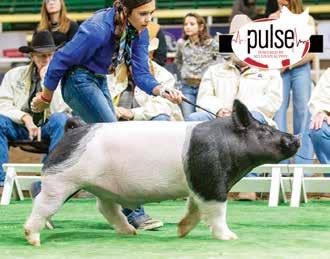
Grand Champion Lamb – Hayden Schroeder of Zephyr, Texas exhibited the Grand Champion Lamb at the NWSS. The Pulse photo Grand Champion Goat – Texas native Dakota Martin exhibited the Grand Champion Goat at the NWSS. The Pulse photo
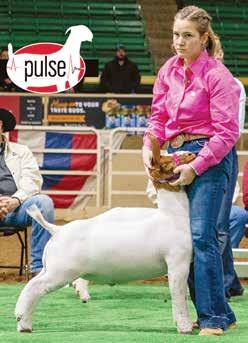
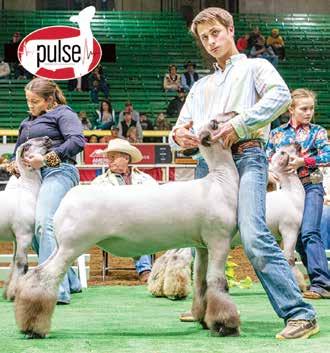
Weathering the freeze – tips to ensure cattle have winter water access provided
With the onset of winter temperatures around the country, cattle producers are busy ensuring their herds are well cared for. Keeping cattle fed with quality nutrition from supplementation to provide protein, energy, minerals and vitamins is top of mind for many.
However, there is another essential nutrient producers can’t afford to overlook – water.
“Water is the most essential nutrient for cattle production,” says Dr. Jon DeClerck, cattle nutritionist with Purina Animal Nutrition. “It’s used for regulating body temperature, growth, reproduction, lactation, digestion and many other bodily functions. Water also drives intake for mineral, forage and supplements. And, while we typically worry more about water intake in summer, it’s equally as important in cold weather.”
For fall-calving herds, water requirements go up drastically during lactation. Cows hit peak lactation right when water is at risk of freezing. With spring-calving herds, water access is key to avoid stress and long-term performance impacts to both the cow and unborn calf.
Below are three tips to keep cattle drinking water during the winter.
Water placement
During extreme cold, wind or moisture, cattle typically stand in a shelter for extended periods of time to conserve body heat.
The easier it is to access water in shelter areas and near feed sources, the less likely cattle will go off of water or burn body heat walking long distances to get to water.
“When using natural water sources, place feeding sites close to the water to encourage access and decrease the chance of water icing up, but far enough away to protect water quality,” says DeClerck.
Water sites should be well drained to avoid mud and ice build-up, which can become a slipping hazard.
Ice management
The best way to manage ice is to prevent water sources from icing up in the first place.
“Automatic cattle waterers have several options to keep ice at bay, including insulated troughs and pipelines, electric and propane heaters, solar power and heat tape or geothermic heat,” says DeClerck. “An added benefit of these types of heated waterers is improved water temperature, leading to more optimal water intake by the animal.”
Maintaining a continuous flow of water is another option for automatic cattle waterers to prevent ice build-up. However, producers need to be aware of overflow issues. Set up a drain to remove excess water and only run continuous flow in preparation for and during inclement weather.
“Managing ice with natural water sources is more of an art than a science,” says DeClerck. “Water can get muddy if ice is chopped too close to the bank, discouraging cattle from drinking. But, if ice is chopped too far out, there is an increase in the risk of slipping, which could lead to broken legs or lost pregnancies. Look for a happy medium to keep cattle safe while maintaining water quality.”
Prepare for the unexpected
Those in the Midwest and North are often profes- sionals when it comes to extreme winter weather. But, in the warmer areas of the country, such as the Southeast, producers may not be as prepared for the once-every10-years winter storm.

No matter where a producer lives, the key is to have a plan.
“When a winter storm rolls in, don’t be left without supplies like water heaters and other essential items,” says DeClerck. “These sell out quickly
McNamee when storms are looming. Make a checklist of musthave items and stock up long before temperatures start dropping.”
Have a pre-storm plan in place and know how to implement it. This plan could include tasks like performing regular maintenance, turning on water heaters and starting continuous flow on automatic cattle waterers.
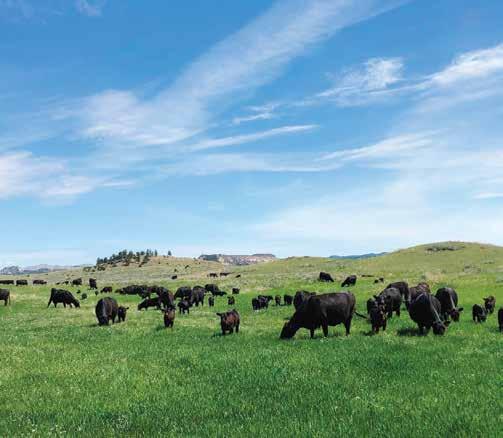
When building a new site, think ahead and con- sider laying pipes deeper and using insulated pipes to prevent freezing. This can save producers a lot of hassle down the road.
This article was provided by Purina Animal Nutrition LLC, a national organization serving producers, animal owners and their families, headquartered in Arden Hills, Minn. and a wholly owned subsidiary of Land O’Lakes, Inc. For more information, visit purinamills.com
Angus Ranch & Cook Angus 35th Annual Bull Sale
February 16, 2023
1 PM • Miles City Livestock Commission, Miles City, MT There
Our bulls breed in large pastures, competing with other bulls, ensuring structural soundness & breeding instinct. Any bull can breed in a single sire breeding unit, but yours don't & neither do ours. All our calves are DNA' d for sire confirmation.
We have always focused on the fertile, low maintenance female. Our cows continue to breed in the mid 90 percentile in these years of drought, fires, grasshoppers, limited water and minimal winter feed. They do this on grass, water and mineral.
We have over 50 years of combined breeding experience backing every bull we sell. Our genetics have been developed in range conditions to excel in range conditions. We are confident our bulls will work for you, because we use our bulls and they work for us.
There is a difference!
Our bulls are affordable, typically averaging $3,500.
50+ 2-YEAR-OLD BULLS
25+ YEARLING BULLS (MOST SUITABLE FOR HEIFERS)
25 BRED HOME-RAISED F1 BALDY 3-YEAR-OLD COWS WHO HAVE RAISED A CALF 3 YOUNG RANCH RAISED & RANCH-RIDDEN SADDLE HORSES







